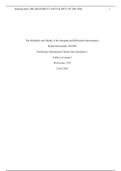Running head: THE RELIABILITY AND VALIDITY OF THE SDQ 1
The Reliability and Validity of the Strengths and Difficulties Questionnaire
Mandy Roosendaal, 2663488
Psychology, Measurement Theory and Assessment 1
Vedika Lal, group 5
Word count: 2935
25-03-2020
, THE RELIABILITY AND VALIDITY OF THE SDQ 2
The Reliability and Validity of the Strengths and Difficulties Questionnaire
According to Kivumbi et al. (2019), 6% of school-going children show symptoms of
oppositional defiant disorder (ODD), 2% show symptoms of conduct disorder (CD), and 2.67%
show symptoms of attention-deficit/hyperactive disorder (ADHD). To provide these children
with the best treatment, they must first be tested to see if they have such a disorder. According to
Gregory (2012), only a reliable and valid test is a good test. His definition of reliability is the
consistency of the results of a test. His definition of validity is that a test measures what it aims
to measure. One such test is the Strengths and Difficulties Questionnaire (SDQ).
According to Stone, Otten, Engels, Vermulst, and Janssens (2010), the SDQ is a paper-
based questionnaire for children between the age of 3 and 16 that can help make individual
clinical decisions. The questionnaire consists of 25 items divided over five subscales: emotional
symptoms (5 items, e.g. “many worries, often seems worried”), hyperactivity (5 items, e.g.
“constantly fidgeting or squirming”), conduct problems (5 items, e.g. “often lies or cheats”), peer
relationship problems (5 items, e.g. “has at least one good friend”), and prosocial behaviour (5
items, e.g. “kind to younger children”). The total problem scale consists of the first four
subscales. The response options for all items are “not true” (0), “a bit true” (1), and “certainly
true” (2). The minimum score on the SDQ is 0 and the maximum score is 50. The minimum and
maximum scores for each subscale are 0 and 10 respectively. On all the subscales within the total
problem scale, the minimum score indicates no problems and the maximum score indicates
major problems. On the prosocial behaviour subscale, the minimum score indicates major
problems and the maximum score indicates no problems. Stone et al. (2010) found an internal
consistency (Cronbach’s alpha) of .80 for the total problem scale and an internal consistency
of .67 for the prosocial subscale. According to COTAN guidelines (table 1), an internal
consistency of .80 is sufficient, but an internal consistency of .67 is not.
This study uses the total problem scale, hyperactivity subscale, and prosocial behaviour
subscale to assess the reliability, and the hyperactivity subscale to assess the validity of the SDQ
in a Dutch sample. Cronbach’s alpha is used to determine the reliability of these scales which,
according to Cronbach (1951), is a measure of internal consistency. Three types of validity are
used. The first is convergent validity which, according to Carlson and Herdman (2010), is
determined by a high correlation between the measure being tested and a measure that is
supposed to measure the same construct and therefore indicates whether it measures what it aims




